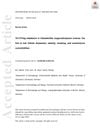Identifying Key Components and Therapeutic Targets of the Immune System in Hidradenitis Suppurativa with an Emphasis on Neutrophils
September 2020
in “
British journal of dermatology/British journal of dermatology, Supplement
”
hidradenitis suppurativa neutrophils hair follicle unit bacterial components complement pathway anaphylatoxins C3a C5a tumor necrosis factor-alpha interleukins IL-17 IL-8 CXCL8 IL-36 IL-1 lipocalin-2 leukotriene B4 platelet-activating factor kallikreins matrix metalloproteinases myeloperoxidase inhibitors HS TNF-alpha MMPs

TLDR The article suggests that targeting specific immune pathways could help control and treat the skin disease hidradenitis suppurativa.
The review article from February 2021 focused on the role of neutrophils in the pathogenesis of hidradenitis suppurativa (HS), a chronic and debilitating inflammatory skin disease affecting the hair follicle unit. It highlighted the importance of neutrophil recruitment to HS lesion sites, which is believed to be a key factor in the development of the disease's characteristic painful nodules and abscesses. The review discussed the major mediators involved in this process, including bacterial components, complement pathway anaphylatoxins (C3a and C5a), tumor necrosis factor-alpha, various interleukins (IL-17, IL-8/CXCL8, IL-36, IL-1), lipocalin-2, leukotriene B4, platelet-activating factor, kallikreins, matrix metalloproteinases, and myeloperoxidase inhibitors. It suggested that pharmacological targeting of these pathways could potentially control and stabilize HS lesions and induce remission of severe flares.


